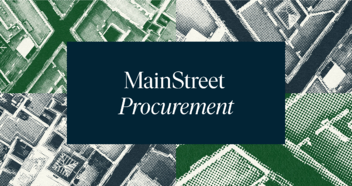6 Negotiation Tips to Reduce Your Company Spend
Whether you're a first-time founder or a seasoned buyer, these negotiation tips will help you get more out of your bottom line.
As a cash-strapped startup, every dollar saved is a dollar you need to track and manage. When most of your capital is tied up in software, suppliers, and miscellaneous costs, saving money can feel like a pipe dream at best. In this ever-changing environment, most startups end up wasting tens, even hundreds, of thousands on extraneous expenses. But what if your most expensive suppliers were actually willing to negotiate for a better price?
Most startups deal with “SaaS creep”, or the slow and steady increase of their software stack costs over time, but few have the capacity to combat this. Left unchecked, this quiet accumulation can have lethal consequences on your bottom line. But here’s a secret: you can negotiate with almost any vendor. Here’s why (and how) you should.
Why negotiate with SaaS vendors?
The average startup uses 102 different SaaS apps for daily business needs (!!!). On top of this avalanche of software solutions, there are cloud services, virtual desktops, and a myriad of tech-related services holding startup cash hostage. Sure, some of these expenses are a necessary part of doing business. But when you take a closer look, you’ll find duplicative services, unused subscriptions, and additional hidden fees that are putting an unnecessary strain on your company spend.
Negotiating with your vendors can help you eliminate redundancies, remove orphaned subscriptions, and reduce costly app churn. Whether you’re looking to lower the costs of internal tooling or CRM systems, or smaller apps in your tech stack, negotiating for a better price will save you serious money in the long run.
. . . . . .
Key Components of Vendor Negotiations
Almost of your vendors can be negotiated with. In fact, almost every SaaS sales team has pricing flexibility. They can give you a deal. But you have to earn it. How? Here are the key components of nearly every vendor negotiation:
1. Communicate Often
Sometimes we forget that behind every company or piece of technology, there are real humans calling the shots. Constant, open, and honest communication is the single most important part of the negotiating process. Or, as Dr. Mareike Schoop, Professor of Information Systems at the University of Hohenheim, puts it: "Negotiation cannot be performed without communication as communication is the essence of negotiation and bargaining."
Try using the same point of contact during the entire negotiating process. Whether you're negotiating in-house or using a professional negotiation service, someone needs to build a rapport with your vendor. It may sound simple, but vendors are more willing to give discounts to people they like.
Consider these communication tips:
-
- Reply to emails in a timely and professional manner
- Make communication personal
- Build long-term relationships by using a regular point-of-contact
- Work with someone who is good at communicating or use a personable employee familiar with negotiation
2. Research Competitor Pricing
How much do your vendors' direct competitors charge? You need to know. Not only does competitor pricing help you understand whether you're getting a good deal, but it also gives you an advantage. As a valued customer, your vendors want to keep your business. It is five times more expensive for a company to find a new customer than to keep an existing one.
It's a buyers' market. To master your negotiation, you need to understand how much everyone is charging in your vendors' ecosystem. Once you do, you can push your vendor towards matching lower-priced competitors.
Consider these competitor pricing tips:
-
- Come prepared with a working knowledge of your current contract and how it compares to competitive offers
- Partner with someone who understands how to obtain and leverage competitor pricing
- Ask vendors to explain why their pricing is higher than specific competitors
- Be prepared to leverage your communication skills to counter any feature-based distractions (eg. "we charge more because we have X feature that our competitors don't offer.")
3. Pinpoint Their Differences
All vendors have qualities that make them unique, allowing them to justify their pricing patterns. The more you know about your vendors (and their competition), the easier it is to sit down and have a transparent negotiation.
No one knows your business better than you, so be prepared to pinpoint which features are deal-breakers and which you can live without. Competitive vendors tend to offer similar services, but there’s always something that sets them apart. If your SaaS marketing tool offers better integrations or features directed toward your niche market, you probably want to keep using their product. Knowing which features benefit (or detract from) your day-to-day will help you determine which vendor is the better fit for your business.
Consider these differentiation tips:
-
- Compare and contrast competitive offerings during your negotiation
- Come prepared with a list of the features you need versus those that are simply “nice to have”
- Tell your vendor if you like (or dislike) certain unique features; it highlights that there’s more to this negotiation than just asking for a lower price. Plus, you might get clued in on some features that are soon to be released.
4. Get Quotes
It’s one thing to talk about looking elsewhere, it’s another to come prepared with competitive quotes. Competition drives down prices and lets your supplier know that you mean business. Sales teams are specially trained to overturn objections and speak to their competitive edge, but they ultimately want to keep you as a customer. A quote from a comparable vendor may help you leverage a lower price, increase service offerings, or even level up your subscription to a higher tier.
That said, don’t weaponize your quote. Being rude or threatening will get you nowhere fast. Instead, find a way to organically bring up the competitive offer and let them know how this information is affecting your decision-making process.
Consider these tips for getting quotes:
-
- Reach out to every vendor in their space to get a quote (if you have the time)
- Reference these quotes regularly during your negotiation
- Be willing to go beyond quote conversations with competitors; you may find that their offering is truly a better fit for your business
5. Demonstrate Commitment (Without Sounding Desperate)
You don't want a vendor; you want a partner. Let them know how you can help them achieve their goals. For example, you may be able to bring them referrals, promote them on social channels, or participate in a customer case study. Ideally, every vendor relationship creates value for both parties. You don't want to negotiate anyone into a corner. Show them that you're committed without sounding like you would do anything for their service.
Remember, always have a plan B. You can walk away. They know that; you know that. But let them know walking away isn't what you want. You want to be partners.
Consider these commitment tips:
-
- Try to find a way that ensures both parties win
- Let your vendor know how much you love their company and/or services
- Show off your ability to provide them with more business
6. Try a New Angle
Vendor not playing ball? Time to try something different. Instead of trying to negotiate for a lower price, pivot your approach to get an increase in service. Or, if that doesn't work, attempt to change terms, create flexibility with payments, or get discounts for hitting certain milestones.
Virtually every salesperson has some level of "freedom" in the negotiation process (i.e., they may be able to lower prices, eliminate overages, bump up service tiers, etc.) You need to find where that freedom lies, and attempt to get the best deal for your business.
Consider these alternative options:
-
- Ask about fee removal
- Discuss terms in the service-level agreement (SLA) that may have flexibility
- Try for "freebies", like extra users, integrations, etc.
. . . . . .
At the end of the day, negotiations are almost always worth it. These tips can help any founder lower their bottom line. It’s up to you to determine if you have the time and resources available to really commit. Between a lengthy research process, building relationships with vendors, and hours of back-and-forth communication, most founders would rather keep paying full price.
Luckily, that’s where MainStreet steps in. We’ve helped thousands of startups and small businesses secure lower prices and better features on their biggest spends. With MainStreet Procurement, we step in and handle your negotiations, from research to contract. We partner with your business to ensure you’re getting the best possible deal, without sacrificing your valuable time and resources.

.png%3Fwidth=352&name=Savings Tips (small).png)
